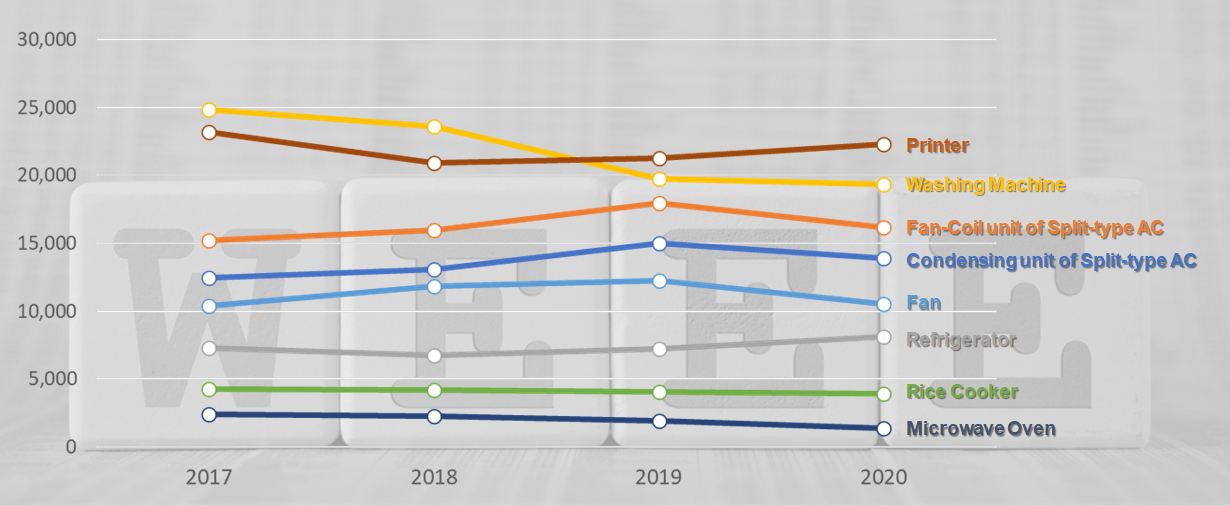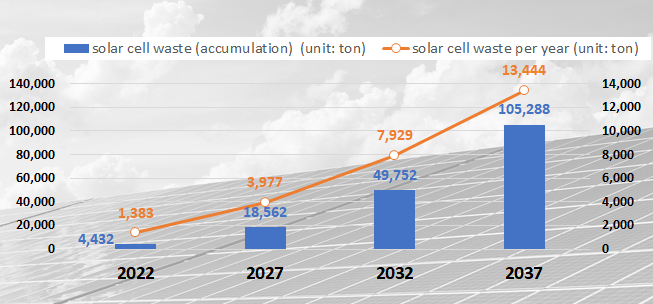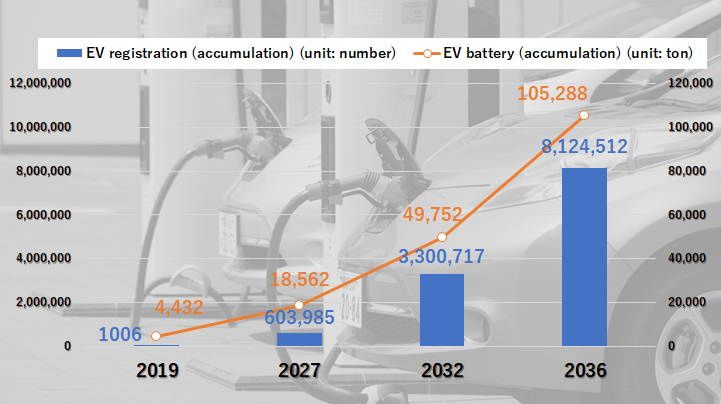Waste electrical and electronic equipment (also known as WEEE or e-waste), which includes a wide range of end-of-life devices such as computers, refrigerators and mobile phones, is considered as a waste category that sees the highest growth rate due to our modernized life that depended largely on electrical appliances and computer systems. In Thailand, the issue of waste management has been identified as a national agenda. The National strategy on WEEE was approved by the cabinet in 2007 and recently the WEEE Management Bill has been proposed, drafted and recently revised to cope with such a problem. The latest version of the Bill was circulated for public hearing on April, 2021.
On July 2021, the Pollution Control Department has published a draft version of WEEE Integrated Management Action Plan B.E. 2565 – 2569 (2022 – 2026) on its website. This draft Action Plan shows the current situation of WEEE management, the current regulations and policy on WEEE, and outlook on activities under the Action Plan. Hereinafter this article will review these issues.
1. Current Situation of WEEE generation
The report on hazardous waste discharged from local communities during the year B.E. 2563 (2020), issued by the Pollution Control Department, has shown that the amount of e-waste generated is at approximately 418,113 tons per year. Another survey result also shows that about 80 percent of e-waste has potential for recycling. Currently, management of e-waste in Thailand is still inadequate. Approximately 90 percent of the amount of waste electronic appliances discharged from households are disassembled for recycling and the rest of the waste is disposed together with general solid waste. The general solid waste management system in Thailand is not designed to handle hazardous waste. Some of products that did not pass quality control are stored as waste at the manufacturing plant without any plan for disposal and there is no commercial recycling process for remains of some small products, such as fluorescent lamps and batteries.
According to information from the Electrical and Electronics Institute and the Office of Industrial Economics, the production volume of electrical and electronic products in Thailand during the year 2017 to 2020 is quite stable as shown in table below.
| Type of product | Units produced (thousand) | |||
|---|---|---|---|---|
| 2017 | 2018 | 2019 | 2020 | |
| Condensing unit of Split-type AC | 12,493 | 13,105 | 15,010 | 13,894 |
| Fan-Coil unit of Split-type AC | 15,199 | 16,000 | 17,991 | 16,185 |
| Refrigerator | 7,296 | 6,730 | 7,211 | 8,116 |
| Washing Machine | 24,836 | 23,613 | 19,775 | 19,363 |
| Fan | 10,364 | 11,854 | 12,282 | 10,562 |
| Rice Cooker | 4,241 | 4,168 | 4,032 | 3,941 |
| Microwave Oven | 2,384 | 2,305 | 1,957 | 1,415 |
| Printer | 23,201 | 20,909 | 21,282 | 22,280 |

Results of a survey, which was conducted by the Pollution Control Department in 2012 under a project to develop guideline for the assessment of wasted electrical and electronic products, found that service lives of 10 types of electrical and electronic products are between 3.09 (mobile phones) – 6.9 years (refrigerators).
In 2020, the amount of WEEE generated was 418,113 tons. Of these, 214,056 tons were collected from households, 170,545 tons were sold to second-hand shops, 43,152 tons were sorted by local communities, and 360 tons were collected by local government organizations. Table below shows the amount of wasted electrical and electronic products generated during the year 2017 – 2020. It is shown that the total amount of WEEE increases continuously during the term. This should be a result of the rapid technological development, which often leads to replacement of electrical and electronic products. Importing low quality products also causes short service lives of electrical gadgets. Additionally, most people discard WEEE together with general waste, which results in inappropriate handling of WEEE, causing impacts on public health and the environment.
| Type of WEEE | Amount of WEEE (ton/year) | |||
|---|---|---|---|---|
| 2017 | 2018 | 2019 | 2020 | |
| Television | 98,369.71 | 89,612.65 | 99,447.71 | 100,515.36 |
| Air Condition | 75,419.61 | 76,653.41 | 77,653.41 | 78,639,32 |
| Refrigerator | 63,884.71 | 64,970.07 | 65,995.07 | 66,880.48 |
| Washing Machine | 60,815.64 | 61,927.60 | 62,807.60 | 63,719.55 |
| Computer | 56,087.54 | 58,261.41 | 59,711.41 | 60,756.21 |
| CD/DVD player | 30,436.42 | 32,630.77 | 32,830.77 | 33,175.65 |
| Telephone | 8,797.58 | 11,824.85 | 12,915.30 | 14,240.98 |
| Digital Camera | 7,539.99 | 9,773.73 | 9,973.73 | 10,185.45 |
| Sum | 401,397.21 | 414,654.49 | 421.335.00 | 428,113.00 |
As solar cells and electric vehicles (EVs) have become more popular, researchers have expected the increased amounts of wasted solar cells and EV batteries in the future. For example, a Chulalongkorn University’s study has forecasted the amount of solar cell waste by the year 2022 to be approximately 1,383 tons per year, with the cumulative amount of about 4,432 tons with a tendency of continuous increase due to the high demands for solar cells. The study also estimated that, by 2027, approximately 3,977 tons of solar cell scrap would generate per year with the cumulative amount of approximately 18,562 tons.

On the other hand, the King Mongkut’s Institute of Technology Ladkrabang has estimated the amount of electric vehicle batteries discarded during 2019 to 2036 based on the number of registered EVs. In 2019, there were approximately 691 new registered EVs, approximately 1,006 cumulative EVs, and accumulated battery weight of approximately 4,432 tons with a tendency to increase steadily. It is forecasted that by 2027, there will be approximately 1,452,971 new registered EVs, approximately 8,124,512 EVs and approximately 105,285 tons of accumulated battery weight to deal with.

2. Current Regulation and Policy on WEEE
Currently, WEEE is classified as Class 3 Hazardous Substance according to Ministry of Industry Notification on Hazardous Substances List B.E. 2546 since it contains heavy metals such as lead, cadmium, mercury, etc. Lead is mainly from batteries, circuit boards, monitor tubes, and fluorescent lamps; cadmium is often found in printed circuit boards, resistors, cathode ray tubes; and mercury is often found in switches to control the opening/closing of the circuit board. These heavy metals can, if handled improperly, leak into the environment and be detrimental to health and ecosystems both in the short and long term.
The Pollution Control Department has carried out activities to promote the procurement of goods and services that are environmentally friendly as follows:
- Policy implementation for driving procurement of environmentally friendly goods and services. For example, the Department has drafted an action plan to promote the procurement of environmentally friendly products and services 2021–2027;
- Integrating the requirements for environmentally friendly products and services into existing requirements for environmentally friendly products and services related to electrical appliances such as criteria for “Green Office” by Department of Environmental Quality Promotion. Since 2020, green procurement criteria for electrical and electronic products in the government have been introduced on the following products and service: 1) Photocopier 2) Printer 3) Photocopier rental service and 4) Primary battery.
The Ministry of Finance has issued the Ministerial Regulation Prescribing Supplies and Procurement Methods that the State Wishes to Promote or Support (No. 2), B.E. 2563 (2020) dated December 8th 2020 in the Government Gazette on December 22nd 2020. This ministerial regulation facilitates the promotion of procurement of goods and services that are environmentally friendly, where the term “Environmentally Friendly Supplies” means goods and services with less impacts on the environment than the equivalent products or services but with the qualifications or quality the same or higher than the equivalent products or services. The regulation takes into account the process of procurement of raw materials, production, transportation, use, return to use, recycle and disposal.
3. Outlook on Activities Under WEEE Action Plan
The Pollution Control Department has set 5 objectives of action plan as
- To ensure that the targeted WEEE are handled in a safe and environmentally friendly manner;
- To develop a database on the amount of e-waste;
- To create an efficient and sustainable system for collecting WEEE from citizens and local communities with participation of stakeholders;
- To promote the establishment of a factory to sort and recycle collected WEEE in an environmentally friendly manner; and
- To create environmental awareness on the disposal of WEEE among citizens.
Three main targets of the Action Plan are:
- Setting a system for sorting and collecting WEEE that are efficient and according to scientific principles.
- For 5 categories of WEEE, namely (1) computers (2) telephone and cordless telephones (3) air conditioners (4) televisions and (5) refrigerators: To achieve an average collection rate of 10% or higher of the total amount expected to generate within the year 2026.
- For new types of WEEE such as solar cells and EV battery: To achieve an average collection rate of 5% or higher of the total amount expected to generate within the year 2026.
- Targeted WEEE are disassembled/recycled/wasted properly.
- For 5 categories of e-waste, namely (1) computers (2) telephone and cordless telephones (3) air conditioners (4) televisions and (5) refrigerators: To achieve average proper disassembly/recycle/waste disposal rates of 10% or higher of the total amount expected to generate within the year 2026.
- For new types of WEEE such as solar cells and EV batteries: To achieve average proper disassembly/recycle/waste disposal rates 5%or higher of the total waste products that are expected to generate within the year 2026.
- To support establishment of at least one e-waste sorting and recycle facility with the principle of Environmentally Sound Management (ESM) in northern, northeastern, and southern regions of the country by the year 2026.
This action plan was published on Pollution Control Department’s website for public hearing, after such hearing, the plan will be presented to Pollution Control Committee. After getting approval, related agencies will set up projects and budget according to their duties on such activities. The Pollution Control Department will track progress of each activity and report to it The Pollution Control Committee.
 Thailand, Draft WEEE Action Plan 2022 – 2026
Thailand, Draft WEEE Action Plan 2022 – 2026
























